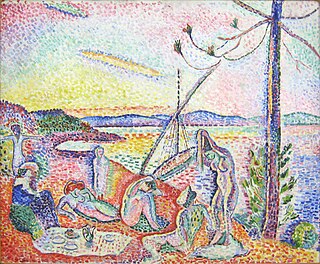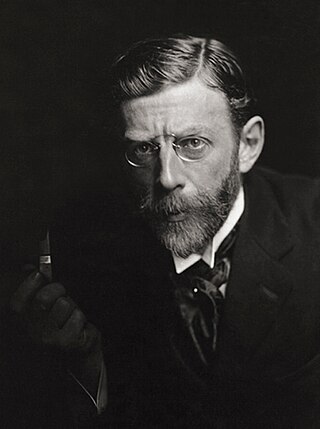
Édouard Manet was a French modernist painter. He was one of the first 19th-century artists to paint modern life, as well as a pivotal figure in the transition from Realism to Impressionism.

Marc Chagall was a Russian and French artist. An early modernist, he was associated with the École de Paris as well as several major artistic styles and created works in a wide range of artistic formats, including painting, drawings, book illustrations, stained glass, stage sets, ceramics, tapestries and fine art prints.

The Salon des Refusés, French for "exhibition of rejects", is generally known as an exhibition of works rejected by the jury of the official Paris Salon, but the term is most famously used to refer to the Salon des Refusés of 1863.

The Salon d'Automne, or Société du Salon d'automne, is an art exhibition held annually in Paris. Since 2011, it is held on the Champs-Élysées, between the Grand Palais and the Petit Palais, in mid-October. The first Salon d'Automne was created in 1903 by Frantz Jourdain, with Hector Guimard, George Desvallières, Eugène Carrière, Félix Vallotton, Édouard Vuillard, Eugène Chigot and Maison Jansen.

The Société des Artistes Indépendants or Salon des Indépendants was formed in Paris on 29 July 1884. The association began with the organization of massive exhibitions in Paris, choosing the slogan "sans jury ni récompense". Albert Dubois-Pillet, Odilon Redon, Georges Seurat and Paul Signac were among its founders. For the following three decades their annual exhibitions set the trends in art of the early 20th century, along with the Salon d'Automne. This is where artworks were often first displayed and widely discussed. World War I brought a closure to the salon, though the Artistes Indépendants remained active. Since 1920, the headquarters has been located in the vast basements of the Grand Palais.

Rupert Charles Wulsten Bunny was an Australian painter. Born and raised in Melbourne, Victoria, he achieved success and critical acclaim as an expatriate in fin-de-siècle Paris. He gained an honourable mention at the Paris Salon of 1890 with his painting Tritons and a bronze medal at the Paris Exposition Universelle in 1900 with his Burial of St Catherine of Alexandria. The French state acquired 13 of his works for the Musée du Luxembourg and regional collections. He was a "sumptuous colourist and splendidly erudite painter of ideal themes, and the creator of the most ambitious Salon paintings produced by an Australian."

Giuseppe De Nittis was one of the most important Italian painters of the 19th century, whose work merges the styles of Salon art and Impressionism.

Alexei Alexeievich Harlamov (1840–1925) was a Russian painter, who usually signed his name in the Latin alphabet as Harlamoff.

Aimé Nicolas Morot was a French academic painter and sculptor.

Leon Dabo was an American tonalist landscape artist best known for his paintings of New York State, particularly the Hudson Valley. His paintings were known for their feeling of spaciousness, with large areas of the canvas that had little but land, sea, or clouds. During his peak, he was considered a master of his art, earning praise from John Spargo, Bliss Carman, Benjamin De Casseres, Edwin Markham, and Anatole Le Braz. His brother, Scott Dabo, was also a noted painter.

René-Paul Schützenberger was a French Post-Impressionist painter.

Fauvism is a style of painting and an art movement that emerged in France at the beginning of the 20th century. It was the style of les Fauves, a group of modern artists whose works emphasized painterly qualities and strong colour over the representational or realistic values retained by Impressionism. While Fauvism as a style began around 1904 and continued beyond 1910, the movement as such lasted only a few years, 1905–1908, and had three exhibitions. The leaders of the movement were André Derain and Henri Matisse.

Jules Alphonse Ernest Renoux was a French painter working during the height of French Impressionism and the Belle Epoque.

Salon des Cent was a commercial art exhibition in Paris, based at 31 Rue Bonaparte. The Salon sold color posters, prints and reproductions of artwork to the general public at reasonable prices. It was established in February 1894 by Léon Deschamps, founder of La Plume an avant garde literary and artistic magazine. It became known for its exhibitions showcasing the works of contemporary graphical artists. The salon held exhibitions until 1900. Many of the posters advertising Salon des Cent exhibitions have themselves become collectors' items.

Léon Zack (1892–1980), also known as Lev Vasilyevich Zak, was a Russian-born French figurative and later abstract painter and sculptor. He has been described as a School of Paris painter.

Antonio García Vega is a Mexican artist and member of the Salón de la Plástica Mexicana. He began exhibiting his work while still in school in the early 1970s and continues to do so, often working with his brother Mauricio García Vega. He works in mixed media to paint various forms of expression. His early work was mostly fantastic, with elements of eroticism but his later work has been darker as a means of expressing his own feelings and moods. His work has mostly been exhibited in Mexico, often in conjunction with other artists including a 2010 exhibition with his brother at various venues.

Frédéric Samuel Cordey (1854–1911) was a French landscape painter who was a part of the Impressionist movement. He was a close friend of Auguste Renoir, and had a personal fortune that allowed him to work according to his taste, regardless of the publicity and support provided by art dealers.

Henri Beau was a French-Canadian Impressionist painter. He is noted for Chemin en été, La dispersion des Acadiens, L'arrivée de Champlain à Québec, and Les Noces de Cana. Beau is a largely forgotten artist due to his long absence from Canada. His widow Marie Beau worked towards establishing his reputation as an artist in Canada after his death. He was only recognized as a notable artist decades later, with major retrospectives of his paintings celebrating his career by the Galerie Bernard Desroches in Montréal in 1974, and at the Musée du Québec in Québec City in 1987.
Mark Tochilkin, was born in 1958 in Dniepropetrovsk in Ukraine, he is a painter and sculptor. Figurative artist, he is best known for his portraits, landscapes and his musicians. The work of Tochilkin is characterized by his technique and the pictorial mastery of his compositions.

Franz Peter Joseph Kymli was a painter and portrait miniaturist from Germany, who worked in France. His name is also given as Kimly, Kimli, Kumli, Kimlig, Kemli, and Kümlich



















